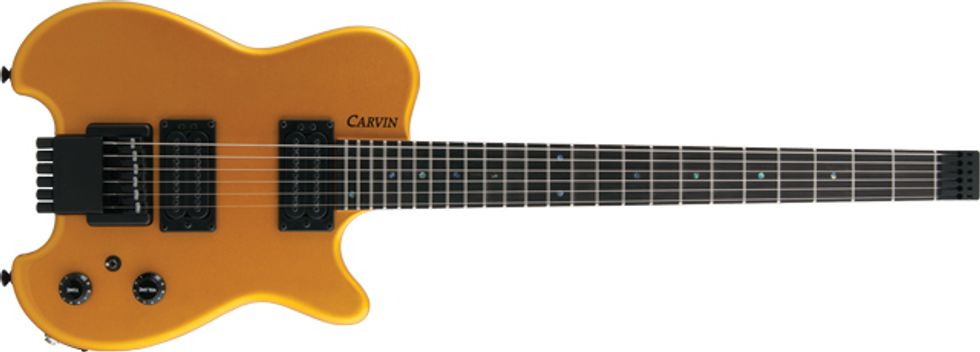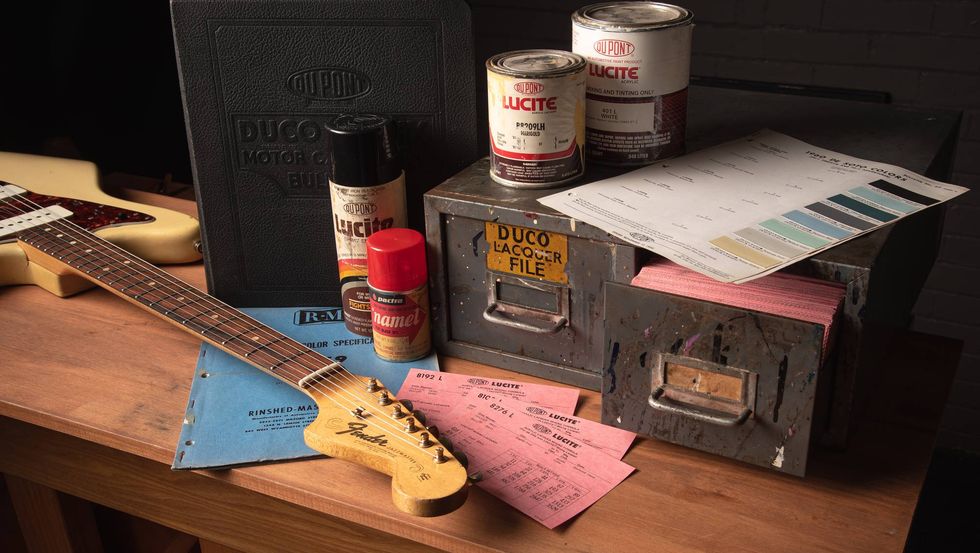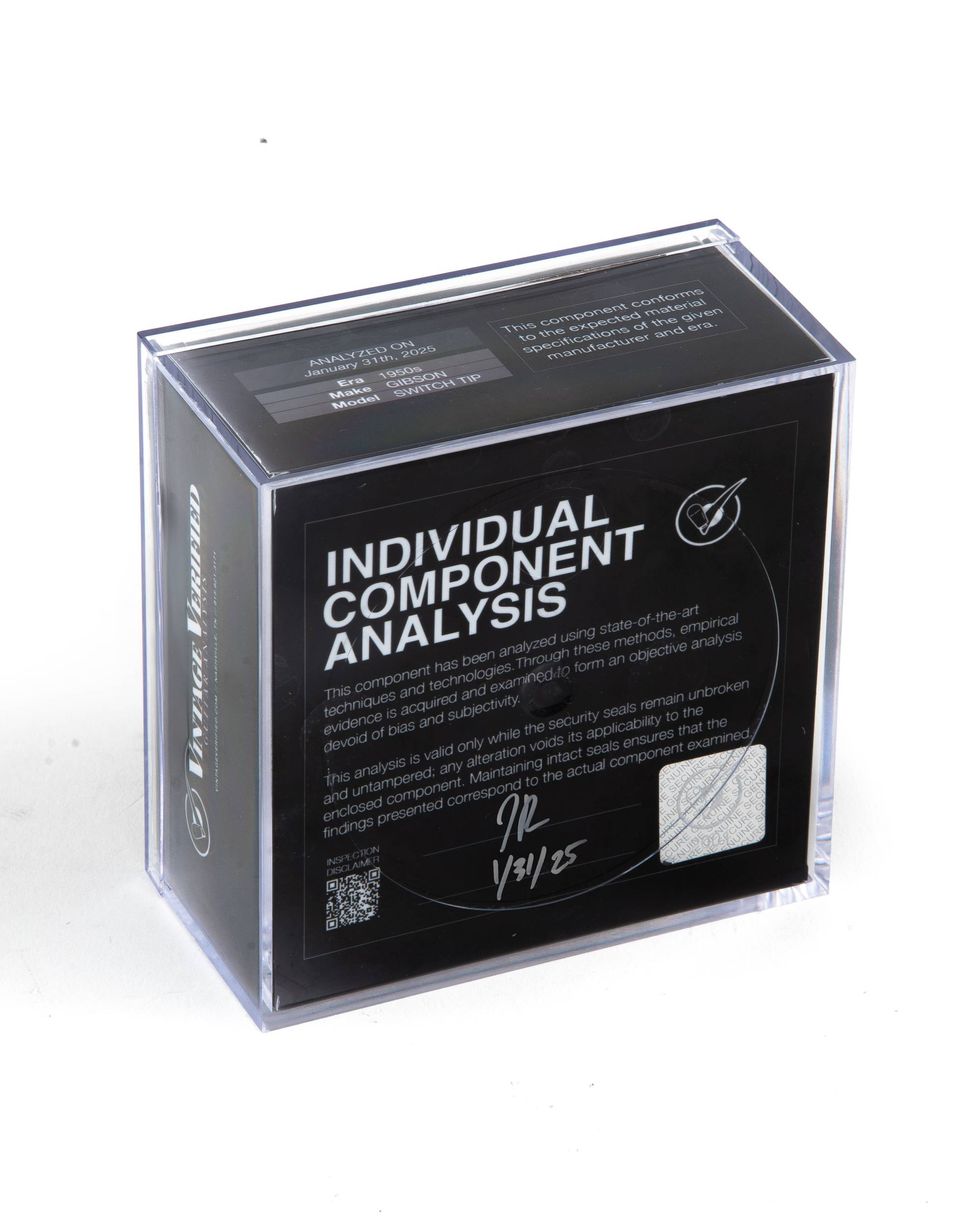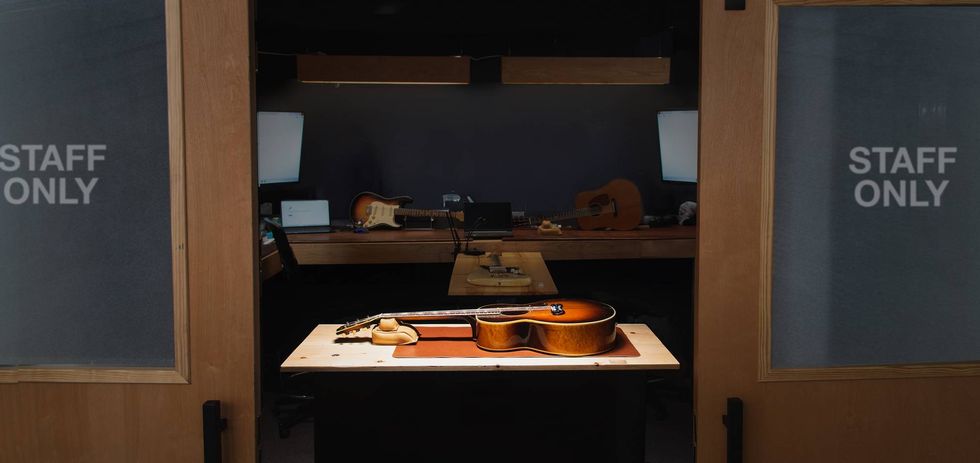Custom shop and boutique guitars are now a multi-faceted business—the domain of collectors, pro players, well-heeled amateurs and aspirational pickers alike. But for a long time, bespoke and “small-batch” guitar making (to borrow a more contemporary brewing term) was by-and-large a fringe business, walking a line between old-American tailored craft and the emerging thought of electric guitars as a fashion accessory.
Carvin was among the first, most interesting, and remains one of the most enduring of these builders. The company, which started in 1946 as a mail-order pickup business, was building mail-order solidbodies by the late ’50s. And in the years since, they’ve offered a wildly varied, unique, and evolving line of electric guitars from their San Diego custom shop, all available with myriad tonewood and hardware options. Carvin still uses the direct sales model as a way to make excellent, accessibly priced guitars available to players. Some of their models start at less than $1,000 and ship within four to seven weeks. That’s quite a contrast to the amount of money and patience typically required when special-ordering a guitar.
These days, Carvins are known for being high-performance machines, so it’s no surprise that the company’s endorsers include hot fusion players like Frank Gambale and Allan Holdsworth. The latter guitarist has a complex and idiosyncratic voice, and not surprisingly, Carvin’s Allan Holdsworth models are some of the most unusual in their catalog. The HH2 is the latest product of the Carvin/Holdsworth partnership.
Sleepy Hollow Shredder
With its headstock-free design, all-in-one
bridge, tailpiece, and tuner assembly affixed
to its tail end, the HH2 will evoke thoughts
of Steinberger for many. But where
Steinberger guitars were made from graphite-
reinforced epoxy, the base HH2 model
is built entirely from wood—a chambered
alder body with a white birch top, along
with an Eastern hard rock maple neck and
an ebony fretboard. Tonewood connoisseurs
will be glad to hear that the neck, body, and
top are also available in various combinations
of figured maple, koa, walnut, and
mahogany. The fretboard is also available in
varieties of maple or rosewood.
The standard bridge on the HH2, a JCustom Headless Research hardtail with knurled-knob tuners, closely resembles that originally made by Steinberg. (A tremolo version is also available, and it includes a locking lever for conversion to a hardtail.) The cleverly designed headpiece will accommodate strings with either double or single ball ends, which is nice if foul circumstances find you without spares or a fellow headless player on the bill. It is not difficult to grow accustomed to this configuration, although tuning with conventionally located machine heads is a quicker and smoother process.
The HH2 is equipped with a pair of humbuckers designed specifically for the guitar. The neck reads 7.3k Ω and the bridge 8.6k Ω, and each pickup has a whopping 11 adjustable pole pieces—a cool feature for the obsessive tone tinkerer. The guitar comes with black coils and bezels, but any combination of black and crème can be ordered. Perhaps due to the diminutive size of the guitar, the pickups share a master volume and master tone control and a metal 3-way mini selector switch specifically requested by Holdsworth. This switch seems a bit fragile, and I’d prefer to see a full-sized component here.
I must confess that when I first removed the HH2, just 31" long, from its undersized hardshell case it felt like something was missing. Even though headless designs have been around forever, it can still strike you as unusual. It also looks small, and the vintage yellow metallic finish tends to highlight some of the more unconventional aspects of the design. The matte black hardware may appeal to some but not others, and I couldn’t help but think how some chrome touches might better complement the futuristic aesthetics. Luckily, at least for my tastes, the guitar is available in translucent finishes like honeyburst and cherry sunburst, which would give the guitar a more respectable look. Unfortunately, at this time, black is the only option for the hardware.
While our review model of the HH2 looks anything but traditional, it boasts tiptop craftsmanship, which is the norm for Carvin. The 24 frets are meticulously done, cleanly seated and polished, and the ebony fretboard has been sanded to silky smoothness. The finish is rubbed to a faultlessly even gloss, and it’s entirely devoid of any orange-peel effect, even in tricky areas like the neck-to-body joint.
Fleet Machine
A player as seasoned and skilled as Allan
Holdsworth is probably pretty in tune with
what he wants from an instrument. And
indeed, the HH2 plays as well as it’s built,
and it feels built for playing above all—a
real exercise in function over form. At just a
little over five pounds, it’s very comfortable
to play in standing position and feels well-balanced
despite—or perhaps because of—its lack of a headstock. It’s very comfortable
to play seated as well (unusual for a headless),
thanks to the Telecaster–inspired silhouette.
And no matter how you play, over
time the lack of headstock becomes a lot
less disorienting.
Ratings
Pros:
Great craftsmanship, killer sounds, and ultra-fast
playability in an idiosyncratic and unique guitar.
Cons:
More than a few will be deterred by the headless design.
Tones:
Playability:
Build/Design:
Value:
Street:
$1,199
Carvin Guitars
carvinguitars.com
The neck on the HH2 feels full in hand, and is capped by a flattish 20"-radius fretboard and 24 jumbo frets (different radii and fretwire are available). Action is predictably low and feels zippy in all registers. This is especially noticeable at the highest frets, which are made considerably more negotiable by a low-profile neck heel. Altogether the neck feels very fast, and it’s especially accommodating of the legato phrasing for which Holdsworth is celebrated.
Through a Fender Deluxe, the Holdsworth displays a range of satisfying tones. The warm neck pickup works particularly well for fingerpicking the complex chord progressions Holdsworth favors, and rolling the tone back summons a dark, but clear timbre that makes this an excellent jazz solidbody.
The bridge pickup is more aggressive, but hardly without refinement, and it works equally well for rootsy rhythm and singing and cutting leads. It doesn’t get strident at higher volumes and sustains beautifully, even at lower output levels. The pickups are nicely balanced in relation to each other too, which invites a lot more tone crafting with the guitar’s controls.
The Verdict
Carvin’s HH2 Allan Holdsworth signature
model will doubtless prove über-appealing
to Allan Holdsworth fans and players
without a bias against headless designs. But
with its tip-top build, smooth playability,
and wide tone profile—not to mention its
modest price—the HH2 is good enough to
tempt those on the fence. Regardless of how
it looks, the HH2 does much to recommend
this California company that, decades
on, is still quietly making killer boutique
guitars to order.









![Rig Rundown: John 5 [2026]](https://www.premierguitar.com/media-library/youtube.jpg?id=62681883&width=1245&height=700&quality=70&coordinates=0%2C45%2C0%2C45)


![Rig Rundown: Russian Circles’ Mike Sullivan [2025]](https://www.premierguitar.com/media-library/youtube.jpg?id=62303631&width=1245&height=700&quality=70&coordinates=0%2C0%2C0%2C0)








